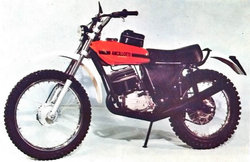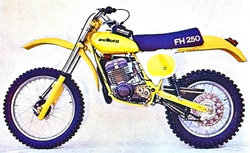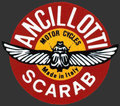Difference between revisions of "Ancillotti"
m |
m |
||
| Line 23: | Line 23: | ||
With their name and brand, they will have written many unforgettable pages in the history of motorcycling - the off road. In fact, in 1967 a big wave of popularity begins with the off road motorcycles and the Ancillotti surf the emerging phenomenom developing, on the Beta base, a couple of models for cross and enduro, respectively of 50 and 60cc, the minimum cubic class of the period. After several presentations and positive trials in motorcycling magazines, with photos of Alberto executing a jump at the "montagnetta" of Milano, and numerous race victories, the new Costruzioni Moto G. Ancillotti soon begins to receive orders for the "Scarab" (the name is derived from the open-winged scarab inserted in the logo) | With their name and brand, they will have written many unforgettable pages in the history of motorcycling - the off road. In fact, in 1967 a big wave of popularity begins with the off road motorcycles and the Ancillotti surf the emerging phenomenom developing, on the Beta base, a couple of models for cross and enduro, respectively of 50 and 60cc, the minimum cubic class of the period. After several presentations and positive trials in motorcycling magazines, with photos of Alberto executing a jump at the "montagnetta" of Milano, and numerous race victories, the new Costruzioni Moto G. Ancillotti soon begins to receive orders for the "Scarab" (the name is derived from the open-winged scarab inserted in the logo) | ||
| + | |||
[[Image:Ancillotti Logo.jpg|left|120px]] | [[Image:Ancillotti Logo.jpg|left|120px]] | ||
| + | |||
In 1970 the German Sachs motors arrive in Italy, and Ancillotti adopts and tunes these powerful 2 strokes with a winning recipe. First, the 50 "short stroke and long stroke", that will color with yellow the parking lots of high schools all over Italy. Then the 125, that will become the most used motorcycle by the cross riders of this class. One can easily say that a whole generation of Italian motocross riders from Curradi, Maddi, Rinaldi, Contini ecc., and also endurists of which the former [[Fabrizio Meoni]] was formed and affermed through the brand with the Scarab. | In 1970 the German Sachs motors arrive in Italy, and Ancillotti adopts and tunes these powerful 2 strokes with a winning recipe. First, the 50 "short stroke and long stroke", that will color with yellow the parking lots of high schools all over Italy. Then the 125, that will become the most used motorcycle by the cross riders of this class. One can easily say that a whole generation of Italian motocross riders from Curradi, Maddi, Rinaldi, Contini ecc., and also endurists of which the former [[Fabrizio Meoni]] was formed and affermed through the brand with the Scarab. | ||
Revision as of 10:08, 29 June 2008
==Ancillotti - four generations in engineering== Source
The long history of the Ancillotti enterprise starts in the 19th century with Ernesto Ancillotti who graduates from being a driver of horse drawn public transport to found one of the first motorized forms of public transport in Florence at the the beginning of the 20th Century. It was inevitable that he would open a workshop for the repair and maintenance of the new motor vehicles, initially automobiles and later motorcycles. Thus begins an engineering enterprise that attracts right from the beginning his son Gualtiero. He is above all fascinated by motorcycles, even the three wheel version, seeing that he will be a prized side car driver.
Shortly after the 2nd world war he opens his own workshop in space reclaimed in the cloisters of the ex-convent of Santa Monica in the artisan's quarters of San Frediano in Florence. In the early 1950's he conceives and patents a suspended frame for the large 2 cylinder Harley Davidsons, based on models used in the army, which would otherwise have had to wait for the duoGlide of 1958 to benefit from the first USA made suspension.
In the early 1960's another American fashion comes to Florence, that of the Go Kart. Gualtiero designs various frames for this new and fun vehicle, and also conceives an ingenious alternative transmission system to bridge the gap due to the absence of differential gears of these vehicles. 125cc motorcycle motors are used. Initially Moto Rumi, MV Agusta, Devil, followed by the (at the time revolutionary and powerful 2 stroke) Bultaco, with which, Piero, the eldest son won some races.
In the mid 1960's, the great amount of experience gained from preparing the 2 stroke motors of the kart is transferred to the preparation of the popular "Cassette", a tuning kit for elaborating the Lambretta. A period in which the scooter dominates the 2 wheel market, almost totally replacing the classic motorcycle. The success of the tuning kit, which also included a special expansion exhaust, designed by Alberto, was so widespread in all of Europe, that the English importer invited the Ancillotti to a "Record Day. It took place on runways of an old military airport of the RAF at Elvington ( Yorkshire). After a few trial runs on the circuit of Monza, they create and hone a Lambretta special 200 with which the son, Alberto, along with the brother Piero, (after an adventurous trip on the roads of those times with a Fiat 600, the special on the roof rack and a spare motor in the boot), rout the competition.
The special, ridden by Alberto, conquers two world records in the category that remained unchallenged for many years. The record for the quarter mile with standing start (15" 129 average speed 96,500 kmh) and on the kilometer with standing start (29" 343 average speed 12 kmh), exit speed of 176 km per hour.
The Boom of scooter popularity declines. Classic motorcycles return on the scene, and the Ancillotti initially team up with the Florentine Moto Beta. After having customized a racing model derived from the Camoscio, with a tuned motor, a magnificent aluminum tank totally hand forged and welded by the great Gualtiero, and a legendary Ceriani fork, with which they achieved some success in uphill competions, they dedicate their attention to that speciality that was then emerging.
With their name and brand, they will have written many unforgettable pages in the history of motorcycling - the off road. In fact, in 1967 a big wave of popularity begins with the off road motorcycles and the Ancillotti surf the emerging phenomenom developing, on the Beta base, a couple of models for cross and enduro, respectively of 50 and 60cc, the minimum cubic class of the period. After several presentations and positive trials in motorcycling magazines, with photos of Alberto executing a jump at the "montagnetta" of Milano, and numerous race victories, the new Costruzioni Moto G. Ancillotti soon begins to receive orders for the "Scarab" (the name is derived from the open-winged scarab inserted in the logo)
In 1970 the German Sachs motors arrive in Italy, and Ancillotti adopts and tunes these powerful 2 strokes with a winning recipe. First, the 50 "short stroke and long stroke", that will color with yellow the parking lots of high schools all over Italy. Then the 125, that will become the most used motorcycle by the cross riders of this class. One can easily say that a whole generation of Italian motocross riders from Curradi, Maddi, Rinaldi, Contini ecc., and also endurists of which the former Fabrizio Meoni was formed and affermed through the brand with the Scarab.
Cycling of superior manageability and stability, coupled with a superpowerful motor for those times, considering that in the Italian championship of 1971, it placed three motorcycles in the first three places with the florentine Curradi, Mercandelli, and Piergentili.
Through the agreement with the Polini brothers, then at Alzano Lombardo, Bergamo, Ancillotti opens his way to the "regolarita" (enduro) of Bergamo. They sold and customized the florentine motorcycles with success. Many Italian titles, and also gold medals won at the Six Days, will arrive. The growth of the company implies transferral to a new and larger site in the industrial area of Sambuca val di pesa distant about 20 km from Florence on the superstrada for Siena.
After the death of the father and founder, Gualtiero, in 1973, the management of the company is taken over by sons, Alberto and Piero. They prove to be worthy of the father, and bring the brand to an even higher level. A succession of sales and racing achievements follow in all of the europeon countries, from France ... to Sweden ... to Finland
Manufacturing with the new assembly line takes off in the golden years of the late 1970's, producing up to 3000 motorcycles per year. These quantities then inexorabily decrease due to waning interest in motocross-enduro and also for the fierce Japanese competition, that progressively eats away greater and greater pieces of foreign markets. With the massive arrival on the Italian market of the colossal Japanese companies, like many other small italian companies, even for the Ancillotti comes the moment of decline. In the mid 1980's, the factory in Sambuca val di pesa closes. In the years, Ancillotti patented interesting ideas, some of which still used today in the production of modern motorcycles throughout the world. To take note of are: the head set with conic roller bearings (1969), rear swing arm rotating on silentblock (1970), Pull-Shock suspension system(1980), Pro-Dive brake system (1984).
Today, the fame of the classic Ancillotti off-road motorcycles lives in the Association "Registro storico Ancillotti Scarab", founded by Alfredo Gramitto Ricci. Its members include many of the owners of the legendary motos with the scarab. It deals with the census and cataloguing of all the models produced, and the restoration of the motos still in existence. It also participates in sporting events like the Italian and European Revival Championship, and organizes the annual meeting and monobrand trophy.
HISTORY BICYCLES
Alberto Ancillotti, under the insistence of his 15 year old son, Tomaso, that wanted a full suspended bike, applies himself to projecting a shock absorbing frame. He is helped in the development by his friend and ex motorcycling work rider Lorenzo Orlando, Naturally, the model of the frame is for the DH, the discipline which most reminded him of motocycles and motocross-enduro.
As father of the Pull-Shock, he immediatley prospected the idea of an evoluted bike, as were evoluted the last motocycles he had projected. Enthusiasm came after having seen one of the first international races in Ciocco in 1991, in which the pilots still competed with rigid bikes or with primitive suspension systems.
He immediatly thought, that in that field still so pioneeristic, through his formidable experience, acquired through years of work on frames and suspensions, he would certainly be able to do something superior and innovative.
Thus, is born, the first frame that mounts, naturally, on the rear swing arm, a linkage suspension of the Pull-Shock type. But not only. On the anterior suspensions is placed a very original (even for motorcycles) Earles type fork, that, however, is not served by the two classic shocks, but rather intergrated by the progressive Pull-Shock system.
External Links



